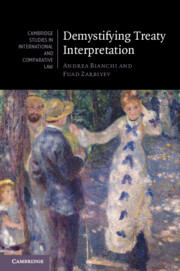Book contents
- Demystifying Treaty Interpretation
- Cambridge Studies in International and Comparative Law: 188
- Demystifying Treaty Interpretation
- Copyright page
- Contents
- Figures
- Preface
- Abbreviations
- 1 The Province of the Rules of Treaty Interpretation
- 2 The Interpreter’s Self
- 3 The Genealogy of the Contemporary Regime of Treaty Interpretation
- 4 Textualism
- 5 Intentionalism
- 6 What’s the Purpose of ‘Object and Purpose’?
- 7 Supplementary Means
- 8 The Magic of Systemic Integration
- 9 Inferential Reasoning and Its Consequences
- 10 Time and Treaty Interpretation
- 11 Text, Author, and Interpretive Control
- 12 Power, Persuasion, and Authority
- Annex Vienna Convention on the Law of Treaties 1969
- Index
- Cambridge Studies in International and Comparative Law
4 - Textualism
Its Unfulfilled Promises and Unintended Consequences
Published online by Cambridge University Press: 07 March 2024
- Demystifying Treaty Interpretation
- Cambridge Studies in International and Comparative Law: 188
- Demystifying Treaty Interpretation
- Copyright page
- Contents
- Figures
- Preface
- Abbreviations
- 1 The Province of the Rules of Treaty Interpretation
- 2 The Interpreter’s Self
- 3 The Genealogy of the Contemporary Regime of Treaty Interpretation
- 4 Textualism
- 5 Intentionalism
- 6 What’s the Purpose of ‘Object and Purpose’?
- 7 Supplementary Means
- 8 The Magic of Systemic Integration
- 9 Inferential Reasoning and Its Consequences
- 10 Time and Treaty Interpretation
- 11 Text, Author, and Interpretive Control
- 12 Power, Persuasion, and Authority
- Annex Vienna Convention on the Law of Treaties 1969
- Index
- Cambridge Studies in International and Comparative Law
Summary
Despite the fact that the Vienna Convention prescribes a holistic approach to treaty interpretation, it is widely believed that the dominant interpretive approach in international law is textualism. Textualism is premised on the distinction between what is inside and what is outside the text of a treaty and assumes that it is possible to interpret a text without reference to factors that are extraneous to it. This chapter situates the preference for textualism in the intellectual history of the discipline. Building on philosopher John Searle’s work, it argues, however, that no treaty interpreter is or can be a textualist. It also introduces the concept of intertextuality and discusses the tension between the official functions of textualism and the practice of treaty interpretation.
Information
- Type
- Chapter
- Information
- Demystifying Treaty Interpretation , pp. 85 - 100Publisher: Cambridge University PressPrint publication year: 2024
